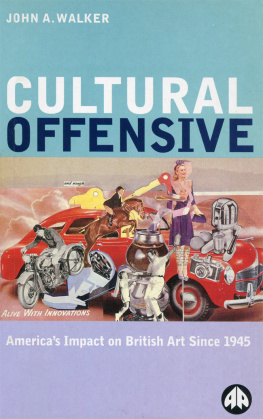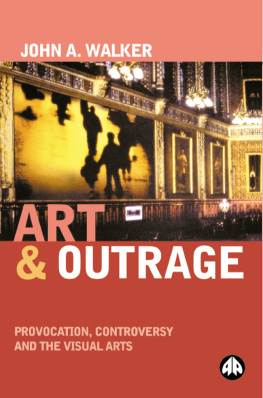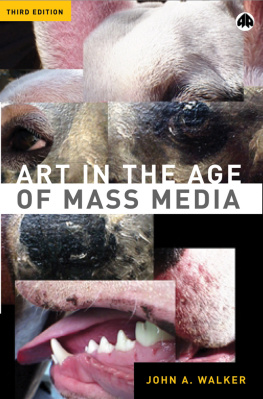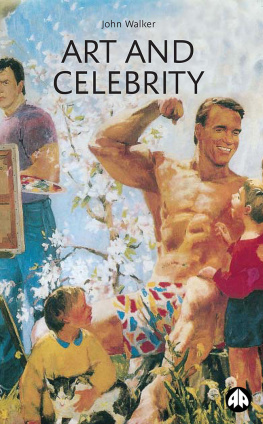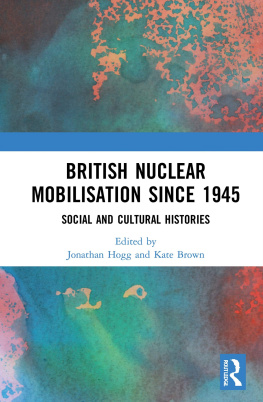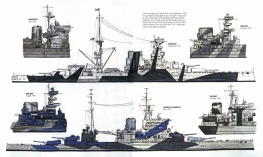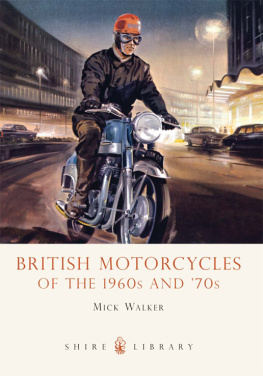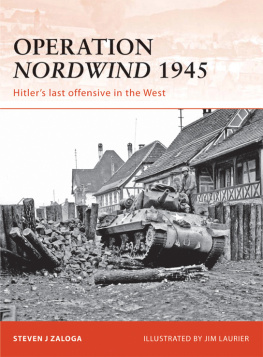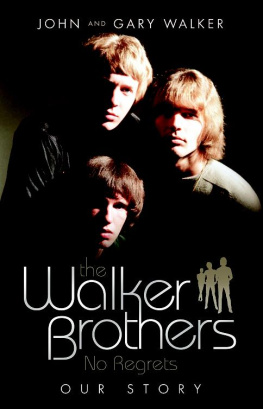Cultural Offensive
Cultural Offensive
Americas Impact on British Art Since 1945
John A. Walker
First published 1998 by Pluto Press
345 Archway Road, London N6 5AA
Copyright John A. Walker 1998
The right of John A. Walker to be identified as the author
of this work has been asserted by him in acccordance
with the Copyright, Designs and Patents Act 1988.
British Library Cataloguing in Publication Data
A catalogue record for this book is available
from the British Library
ISBN 0 7453 1321 3 hbk
ISBN 978 1 7837 1898 6 epub
ISBN 978 1 7837 1899 3 kindle
Library of Congress Cataloging in Publication Data
Walker, John Albert, 1938-
Cultural offensive : Americas impact on British art since 1945/ John A. Walker.
p. cm.
Includes bibliographical references.
ISBN 0-7453-1321-3 (hbk.)
1. Art, BritishAmerican influences. 2. Art, Modern20th centuryGreat Britain. I. Title.
N6768.W25 1998
709'.41'09045dc21
9822146
CIP
Designed, typeset and produced for Pluto Press by
Chase Production Services, Chadlington, OX7 3LN
Contents
Acknowledgements
For information, comments and help, thanks are due to Art & Language, Terry Atkinson, Professor John Ball, Clive Barker, John Boty, Prunella Clough, Magda Cordell-McHale, Roderick Coyne, Barry Curtis, Alan Davie, Nick de Ville, Toni del Renzio, Caroline Edwards, David Enthoven, Bryan Ferry, Adrian Glew (of the Tate Gallery Archive), Mel Gooding, Althea Greenan (of the Womens Art Library), Richard Hamilton, Michael Hazzledine, Janet Henderson, Gordon House, Allen Jones, Peter Kennard, Max Kozloff, Gerald Laing, Mrs S.M. Lanyon, Mark Lancaster, Marco Livingstone, Nigel McKernaghan, Helen and Tony Messenger, Sanna Moore, Lisa Moran, Christine Mulloy, Linda Myers, Paul Overy, Kate Paul, Peter Phillips, Clive Phillpot, Kenneth Prater, John Beldon Scott, Alex Seago, Colin Self, Sylvia Sleigh/Alloway, Peter Smithson, Mary Spear, Chris Stephens, Mark Stringer (of the J.M. Richards Collection, Middlesex University), Stephen Stuart-Smith, Michelle Thomas, Harriet Vyner, Sue Watling, Tom Watt, Hugh Wilford, Malcolm Yorke, and to the British Council, the Reference Center of the United States Information Service, the American Embassy, London, the library staff of Middlesex University, Cat Hill campus and Westminster Central Reference Library.
I am also grateful to Middlesex University for a research grant which provided relief from teaching in order to finalise the text and to Anne Beech for her encouragement and editorial skills, as well as Derek Manley for his assistance with picture research and his helpful comments on the text.
Thanks also to all the agencies, artists, galleries, museums and photographers who kindly supplied images for illustration purposes. Great efforts have been made to trace and acknowledge copyright holders, but if there are any who have been missed, the publishers would be glad to hear from them so that corrections can be made in any future editions.
Introduction
Americanism one dictionary definition of this word is: devotion to or preference for the United States and its institutions.
There are many Britons who have never visited the United States of America in a physical sense but, of course, they have been there thousands of times in their imaginations. Those who are British by birth, education and lived experience, nevertheless feel partly American because so much of their culture has originated there: American jazz, rocknroll, MTV, novels, poems, plays, American-style architecture, paintings and sculptures; aircraft like the Boeing 777, manufacturers such as the Ford Motor Company with factories based in Britain, designed products like IBM computers, Kodak and Polaroid cameras, Remington electric razors, Hoover vacuum cleaners; Coca-Cola and Pepsi drinks, Levi 501 jeans, Harley-Davidson motorcycles, Camel and Lucky Strike cigarettes, Colgate toothpaste, Kellogg cereals, Campbells soups, Nike trainers, Wrigleys chewing gum, fast-food franchises such as McDonalds and Kentucky Fried Chicken; comics like Superman and Spiderman, magazines like Life, Playboy, Readers Digest, Time and Scientific American, and, above all, American movies and television series which have infiltrated and colonised the British psyche. While British children may regret the lack of a Disneyland in the United Kingdom, there is one in northern France a few hours travel away. British holidaymakers in search of sunshine are now as likely to travel to Florida as they are to Spain.
Americas effect upon Britains everyday life and culture an instance of what social scientists term transculturation in all its forms would be a huge subject to explore. Writing in 1987 Andrew Brighton observed:
The USA has been a constant and formative element in the British art world for the last twenty-five years, and a history of postwar British art must address the rise, and now the decline, of its influence.
Art historians routinely discuss the influence of one artist upon another. This book is certainly a study of influence, but we need to elaborate the concept because the responses of artists to foreign art and places are complex and multifarious. (An earlier version of the book title The Americanisation of British Art was abandoned because it suggested a one-way process involving a supine victim.) Michael Baxandall has described influence as the curse of art criticism and has argued that the common sense idea that artist A influences or acts upon artist B, should be reversed because, in reality, artist B acts upon the work of artist A.
Baxandall went on to list the variety of ways in which such acts occur: draw on, resort to, appropriate from, adapt, misunderstand, refer to, engage with, react to, quote, assimilate, copy, paraphrase, make a variation on, ape, emulate, parody, distort, simplify, develop, subvert, transform Thus, while one artist may respond in a submissive manner by adopting and imitating a foreign style, another may react by strengthening their native characteristics; another may selectively appropriate certain elements of the foreign style and then incorporate them into their own work in such a way as to generate a new synthesis; another may be energised and stimulated to experiment in order to push foreign ideas further or in new directions. This means that close attention needs to be paid to exactly how British artists behaved when they were exposed to American visual culture and America itself.
American art, mass and material culture became known to the British in four ways: (1) via the importation into Europe of American art works, books, films, magazines and other manufactured goods; (2) via British artists and critics making visits to, or residing in, the United States; (3) via American artists and critics paying visits to, or residing in, Britain; (4) via American companies investing in British industry or establishing factories and franchises in Britain.
During the period under review, transportation and communication systems increased massively. Thousands of people now fly back and forth across the Atlantic daily, whereas in the 1940s most travelled by sea on liners. After the satellite Telstar was placed into orbit in July 1962, live television transmissions from the United States to and from Europe became possible for the first time. Those British readers who lived through the 1960s will vividly recall the television reports about the assassination of President Kennedy in 1963 shortly after the event. Information, news, goods and people now travel at high speeds around the world and America is thus much closer to Britain at the end of the twentieth century than it was in 1945. However, the rest of the world is also closer.


